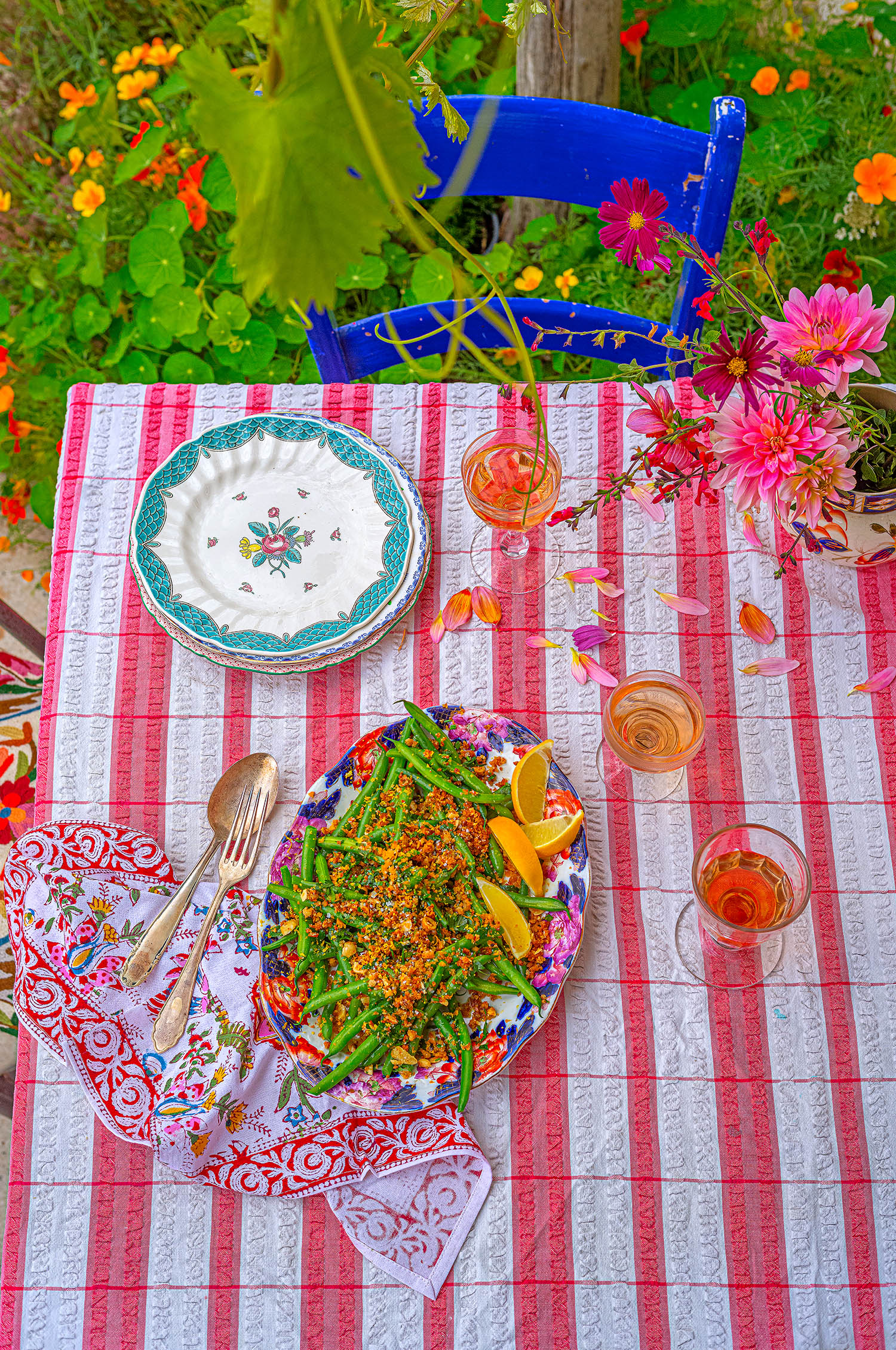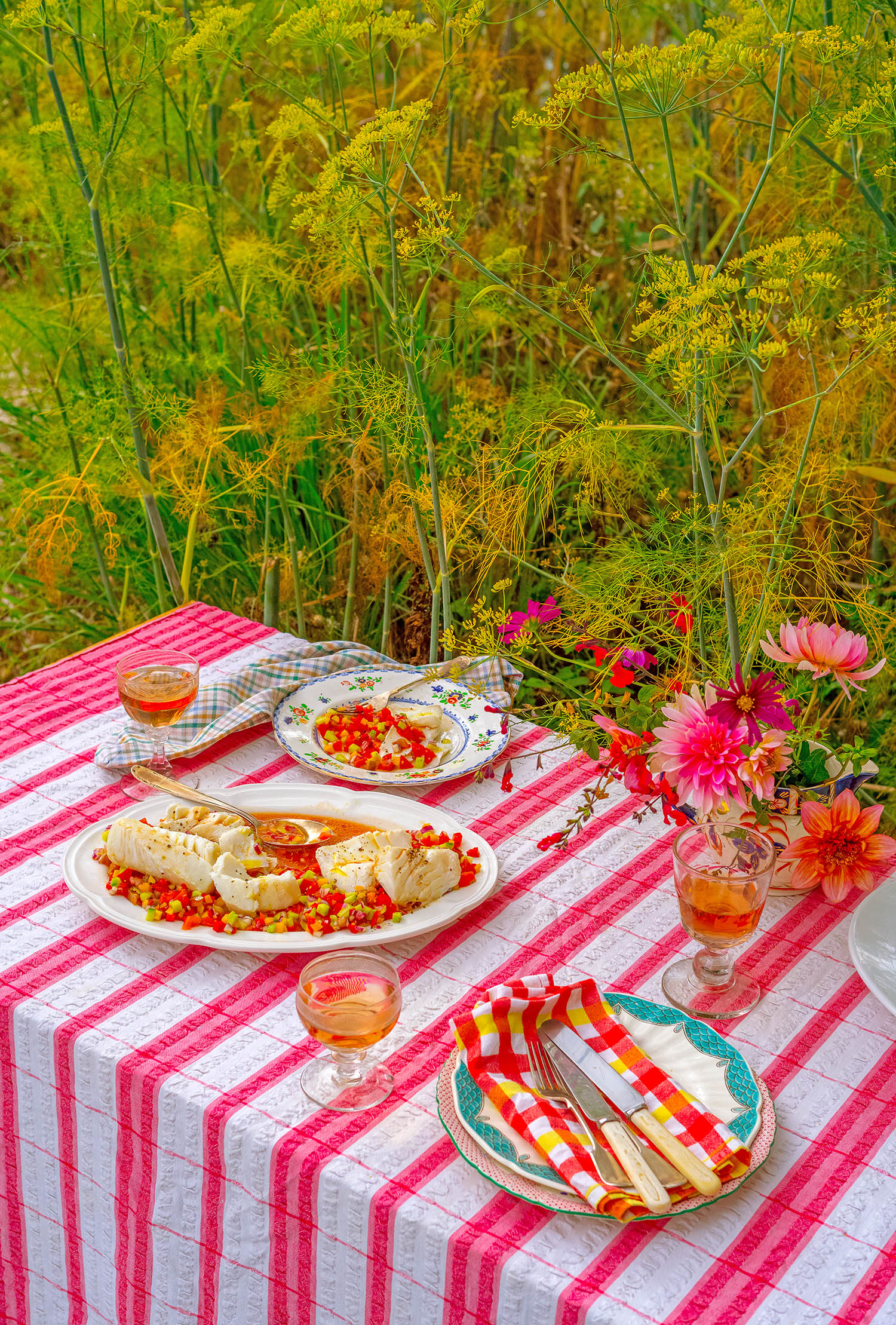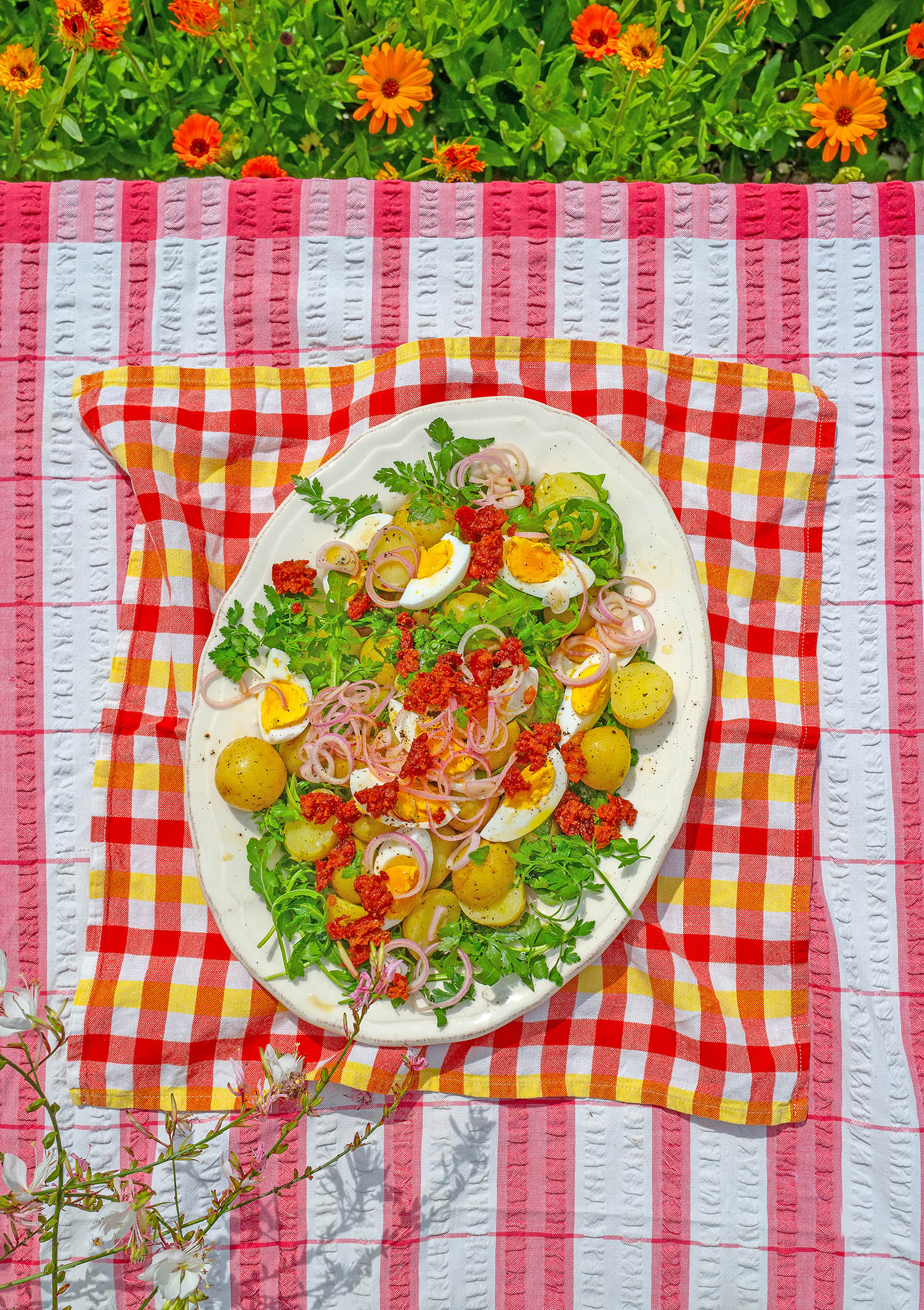Photographs by Romas Foord
A s summer begins to slowly slip away, so do our opportunities to enjoy the best thing about it: languorous lunches in the garden with friends. But it’s got to be a good time for everyone – cooks can’t be sweating in the kitchen while everyone else relaxes. Want to be that host who swans about, drink in hand, basking in the glory of their fabulous party? Let’s help make that happen for you.
The secret is simplicity and planning. This starts with the menu. You won’t impress people with elaborate techniques that take you away from the conversation, but with simple, delicious, inviting food that shows you’ve thought about what they want to eat.
When deciding on my menu, I like to think about heritage and a particular style or cuisine so everything sits together nicely. Then I choose a star dish, something starchy, a salad, a wow-y dessert, add an amusing snack for when people arrive, and you’re nearly there. A not-too-boozy cocktail at lunchtime is always fun. That’s it. Any more and everyone (especially you) will feel overwhelmed.
You do need to put in some work beforehand. A few days in advance, I’ll settle on my menu, gather my ingredients and write a prep list, organising the tasks according to time-sensitivity. This may feel a bit OTT, but it’ll help you feel in control. Do as much as possible in the days ahead (my almond cake is brilliant for this). Some last-minute cooking is fine, but I try to keep it to the final flourish of a dish and have some things done well ahead. Get that table laid early, put on your best outfit, pour some drinks and have a wonderful time.
Americano with olives

This is one of the great lunchtime cocktails, the perfect sweet-bitter balance. It’s refreshing rather than boozy, so you won’t end up sozzled before you start eating. In fact, I find its slight bitterness always makes me even hungrier for lunch. I like to add some good splashes of olive brine to make it even more savoury, but you can tinker with the ratios to make it just how you like it. You may prefer a squeeze of orange or more sparkling water. Serving it in a large jug will be a time-saver, and let guests serve themselves.
Serves 6-8
red vermouth or Cinzano 300ml, or a 40-60 mix of bothCampari 300mlrosemary 1 sprig, bashed to release flavourorange bitters 20-25 shakesorange 1, cut into roundsgreen olives 15, plus 2 tbsp of brine (optional)ice to servesparkling water 600ml, to serve
Combine all the ingredients except the sparkling water in a jug with ice, then let people add their own water and more ice as they like.
Deconstructed gilda crisps
This is a wonderfully attention-grabbing way to start your meal, yet requires very little work from you. Quantities are unimportant here. Love olives? Add more – it’s your party. I like to use Spanish crisps, which, although cost more, are often fried in a little more olive oil than the UK versions, giving them a better flavour and texture. However, any old salted crisp will do. This can be made up to an hour in advance.
Serves 6-8
salted crisps 300gguindillas (or other mild green pickled peppers) 175g, halvedstoned green olives 1 x 350g jar, halvedpickled cornichons and cocktail onions 175g, larger ones halvedanchovies 1 x 50g tin, drained (optional)
Find a large serving plate or bowls and start with a layer of crisps. Scatter over the other ingredients, and repeat until you’ve finished all your ingredients and you have a beautiful tower of crisps.
Green beans with golden fried garlic, hazelnuts, parsley breadcrumbs

This takes inspiration from Catalan picada, made by frying garlic, parsley, nuts and bread in oil and pounding it together to make a paste. It’s traditionally used to enrich sauces and stews, but I’m using it here to add crunch and punch to green beans. You can pre-cook the beans a couple of days in advance and serve them room temperature if you like. You can also get ahead on the constituents of the topping and just fry them together before people arrive.
Serves 6-8
green beans or stringless beans 600gblanched hazelnuts 50gstale bread slices 50g, white or brown, or 50g of breadcrumbsolive oil 50ml, plus 2 tbspgarlic 4 clovesparsley 2 handfuls, washed, dried and roughly choppedorange zest of 1lemon zest of 1, plus extra wedges to serve
Bring a deep pan of salted water to the boil and cook the beans until tender, 5-6 minutes, then drain and rinse under cold water or ideally plunge into a bowl of iced water to keep their vibrant colour. Drain and dry.
Place the hazelnuts and bread (if using whole slices) in a small food processor and blitz until roughly chopped (this can also be done by hand).
Place the beans on a large platter, and toss with a little seasoning and the 2 tablespoons of olive oil. Put to one side.
Warm the 50ml of olive oil in a wide pan over a medium-low heat and add the whole garlic cloves. Fry gently in the oil, about 5-7 minutes until golden and softened, then scoop out the garlic on to a chopping board, and add the hazelnuts and breadcrumbs to the hot oil.
Fry, stirring attentively, until golden and crisp, about 4-5 minutes. Roughly chop the golden garlic and add to the pan, then add the parsley for the last few moments before you take it off the heat. Careful because if it’s wet it will spit.
Spoon the topping over the beans. Zest over the orange and lemon and serve with lemon wedges for everyone to squeeze over.
Cod with fresh tomatoes, cucumber and olive oil

Based on a recipe by the great host Caroline Conran, this dish unites the constituents of gazpacho and uses them to bathe some gently poached cod in their sunshine. Sometimes I poach the fish ahead of time and serve warm or at room temperature. The sauce can be made an hour or two in advance, but I’d recommend not skipping the salting tomatoes step as this prevents it getting too watery while it waits. If you can’t find cod, choose a nice, thick white fish that can withstand poaching.
Serves 6-8
cod loin steaks 6-8 x 150g pieces, or hake, stone bass or halibut (with or without bones)white wine or rice vinegar 3 tbspbay leaves 2salt 1 tspextra virgin olive oil to serve
For the gazpacho sauceripe tomatoes 700g, a mix of sizes and colours, choppedfine sea salt ½ tspred onion ½, choppedextra virgin olive oil 100gsherry vinegar 2-3 tbspgarlic 1 small clovecucumber 1 large, peeled and de-seededred corno or pointed pepper 1, deseeded
To make the sauce, toss the chopped tomatoes in the salt, then place in a sieve to drain away the excess juice (keep this to make a delicious tomato cocktail, or to add to sauces and soups). Set aside for 15-20 minutes. Place the onion in a cup or glass, cover in water, add an ice cube and put aside for 15-20 minutes (to take the edge off the pungent flavour).
Pour the olive oil and sherry vinegar into a mixing bowl and finely grate in the garlic. Start chopping the cucumber and pepper, adding to the oil as you go. Try to make sure everything is cut into similar-sized pieces. Drain the onion and the tomatoes and add them to the other veg. Season to taste, gently toss and put to one side while you poach the cod.
Bring a large, wide pan of water (you can do this in batches if you don’t have a big enough pan) to a simmer with the white wine vinegar, bay leaves and salt. Gently add the cod, making sure it’s submerged, and simmer for 4-5 minutes before turning off the heat and allowing it to sit in the water for another 4-5 minutes.
Transfer the gazpacho mixture to a large, wide serving bowl or platter, nestle in the pieces of cod and drizzle with olive oil before serving.
Herby potato and chorizo salad

Dishes involving chorizo can sometimes feel a bit full-on, but here little morsels of it are used as a background seasoning, allowing the herbs to do the talking. The day before you can pickle the shallots, cook the potatoes and eggs, and even chop the herbs, then combine it before or as people arrive. I also often pre-cook and reheat the chorizo.
Serves 6-8
new potatoes 1kg, larger potatoes halvedeggs 3-4olive oil 5 tbspcider, white wine or rice vinegar 2-3 tbspparsley a small bunch (25g), leaves roughly choppedoregano a small bunch (25g), leaves roughly choppedrocket 60g, roughly choppedmild cooking chorizo 100g, meat removed from skin
For the pickled shallotscider, white wine or rice vinegar 50mlcaster sugar 1 tbspsalt ½ tspboiling water 50mlshallots 2 banana or 4 round, peeled and sliced into rings
Make the shallots first. Place the vinegar, sugar and salt in a jar and pour over the boiling water. Stir until the sugar has dissolved, then add the shallots and gently push them under the liquid. Leave to cool for at least 30 minutes before using (these will keep for up to 2 weeks).
Place the potatoes in a deep pan of salted cold water over a medium-high heat. Once boiling, add the eggs and cook everything for 8-10 minutes. Remove the eggs and test the potatoes. If they aren’t quite cooked, continue to boil until tender. Rinse the eggs under cold water until cool, and drain the potatoes in a colander and leave to steam dry.
Whisk together the oil, vinegar and plenty of seasoning in a large salad bowl and add the cooled potatoes, herbs, rocket and half the pickled shallots and toss together. Have a taste and adjust the seasoning or add more vinegar if you like.
Peel the eggs, cut into quarters and sit on top of the potatoes.
Break the chorizo meat into a frying pan and place over a medium-high heat. Fry, breaking it up into smallish chunks with your spoon. After a few minutes, it should begin to get a little crisper. Use a slotted spoon to remove it (you can add the chorizo oil to the salad if you want a more assertive paprika flavour) and scatter over the salad along with the rest of the shallots before serving.
Almond cake with sherry cream and raspberries

This recipe is based on the traditional Spanish tarta de santiago, a gloriously almondy cake finished with icing sugar and decorated with the Saint James cross. It’s gluten-free, as easy as cake recipes can be and so moist that it can be made several days in advance. The cream can also be made several hours ahead.
The almonds are the star of the show here, so even though it’s an extra step I enthusiastically recommend grinding your own (shop-bought rarely taste of much). I like to serve it with a luxurious amount of boozy cream and raspberries, but it works with all types of cream and fruit, so make it your own. It is – of course – wonderful with just icing sugar if the original, unornamented version appeals to you.
Serves 6-8
lemon zest of 1orange zest of 1caster sugar 250geggs 4ground almonds 300g, ideally freshly groundground cinnamon 1 tspsalt ½ tspraspberries 300g, to serveicing sugar 1½ tbsp, to serve
For the sherry cream
mascarpone 250gdouble cream 150mlicing sugar 1 tbspsweet sherry 3-4 tbsp (optional), such as Pedro Ximenez, or solera, port or rum
Preheat the oven to 160C fan/gas mark 4. Grease and line the bottom and sides of a 20cm cake tin.
Zest the citrus straight into the sugar and use your fingertips to rub them together to release the fragrant oils. Crack in the eggs and use a hand-held electric whisk to beat together for 4-5 minutes until pale and fluffy.
Fold in the almonds, cinnamon and salt, then transfer to the cake tin and smooth the top. Place in the middle of the oven for 35-40 minutes until golden and an inserted skewer comes out clean. Allow to cool in the tin for 20 minutes before transferring to a wire rack to cool completely.
To make the cream, first make sure the mascarpone and cream are fridge-cold. Add the mascarpone to a bowl and use a hand-held electric whisk to beat until smooth, then add the other ingredients and keep going until you get soft peaks – this doesn’t take long.
Spread over the cake, then pile the raspberries on top and finish with a light dusting of icing sugar. I suggest decorating the cake just before serving, but it can easily sit for an hour or two. This will last in the fridge for 5 days.
Georgia Levy is a cookery writer, recipe developer and author of Let’s Do Lunch (Pavilion, £16.99)
